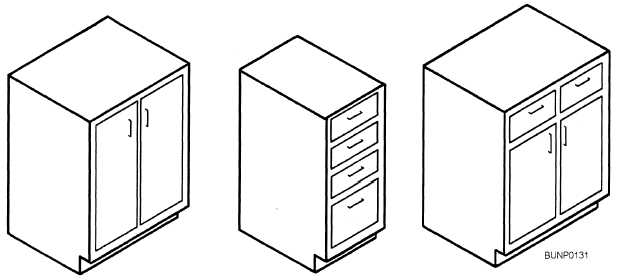be hung. This prevents the doors from binding against the door stops. If the end of the case is to be fitted against a wall, approximately 1/2 inch is added to the width of the stile on that end for scribing.
Doorstops are installed on the back side of the face all around the door openings if flush doors are to be hung. Doorstops project about 5/1 6 inch inside the opening and usually are made of thinner material than the face frame. They are applied with screws and glue because they take much abuse and a strong joint is needed.
Case Tops
The case top is installed according to its location. If it is above the line of vision, the top is cut in between the case ends, so the ends of the top are not visible. The top may also be lowered between the case ends. This provides clearance between the ceiling and the top of the case and also acts as a stop for the top ends of doors. If the top is below the line of vision, it is placed above the case ends.
In most cases, tops are fastened to the cabinet with screws driven up through the top of the skeleton frame.
Counter Tops
The standard kitchen counter top is 36 inches high, 25 inches deep, and 1 1/2 inches thick. This provides enough room for an average-size sink and ample working space on the surface. The counter top is held in place by driving screws up through the top frame of the base unit.
The counter top usually has a 3/4-inch overhang, made of plywood or particle board. It is doubled up by fastening a 2 1/2-inch-wide strip flush with the edges and ends. This gives the appearance of a heavier counter top.
If a backsplash is used, it is usually 4 inches high. It has a 1/4-inch projection on the side that goes against the wall. This projection allows the installer to scribe the counter top to uneven wall surfaces. Prefabricated counter tops may be purchased and cut to any desired length. Special fasteners hold the lengths together.
DESIGNING CABINETS
The Builder should know the proper procedures and correct dimensions on how to build and install cabinets. There are two basic kinds of cabinets - the base unit and the wall unit. The base unit sets on the floor; the wall unit hangs on the wall.
The distance between the wall and base units is usually 16 to 18 inches. The distance is enough accommodate most articles that are placed on counter tops, like coffee pots, toasters, blenders, and mixers. The top shelf in the wall unit should not be over 6 feet from the floor if it is to be in easy reach.
Base Unit
The height of the base unit must be 36 inches to the surface of the countertop. The width must allow for the 3/4-inch overhang of the counter top. Therefore, a standard base unit is usually 34 1/2 inches high by 24 1/4 inches deep. Toe space is provided beneath the base unit. The back edges of the end pieces project 1/4 inch beyond the cabinet back to allow for scribing.
Usually the base unit is constructed with drawers just below the counter top. The drawer opening height is 5 1/2 inches. Some base units contain all drawers or all doors (fig. 5-8).

Figure 5-8. - Typical base units.
Continue Reading